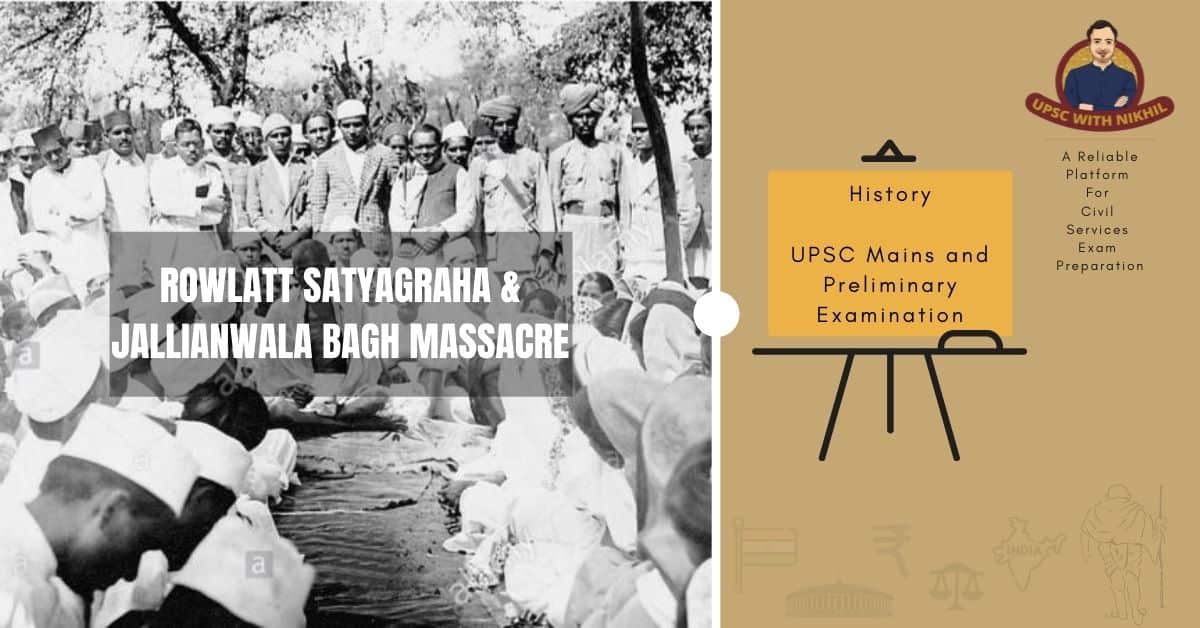Rowlatt Satyagraha & Jallianwala Bagh Massacre
Gandhiji's style and method of politics were demonstrated to the country at large in Champaran, Ahmedabad, and Kheda. They also assisted him in establishing himself among the Indian people and studying their problems up close. As a result of these struggles, he gained a better understanding of the masses' strengths and weaknesses, as well as the viability of his own political style. He also gained the respect and commitment of many political workers, particularly the younger ones, who were impressed by his empathy for ordinary Indians' problems and willingness to champion their cause.
THE ROWLATT ACT:
• In February 1919, Gandhiji used this reservoir of goodwill and experience to call for a nationwide protest against the unpopular legislation that the British were threatening to enact.
• Two bills, dubbed the Rowlatt Bills after the man who chaired the Committee that recommended their introduction, were introduced in the Legislative Council with the goal of severely restricting Indian civil liberties in the name of combating terrorist violence.

• One of them was actually rammed through in haste, despite the opposition of all elected Indian members. This act of the government was viewed as a grave insult by all of political India, especially since it occurred near the end of the war, when significant constitutional concessions were expected.
• After a constitutional protest failed, Gandhiji stepped in and suggested launching a Satyagraha. A Satyagraha Sabha was formed, and younger members of the Home Rule Leagues eager to express their dissatisfaction with the government flocked to join it.
• The old lists of Home Rule League addresses and members were dug up, contacts were made, and propaganda began. The form of protest that was ultimately chosen was a nationwide hartal (strike) accompanied by fasting and prayer. It was also decided that civil disobedience would be used in response to specific laws.
JALLIANWALA BAGH MASSACRE
• The date for the launch of the Satyagraha was set for the 6th of April. The movement that arose was nothing like the one that had been predicted or planned. Because of some confusion about the dates, the hartal in Delhi was held on March 30th, and there was a lot of violence on the streets. This seemed to set the tone for most other areas that responded to the call; most protests were met with violence and disorder.
• Punjab, which was suffering from the aftereffects of severe wartime repression, forcible recruitment, and disease, reacted particularly strongly, and the situation became extremely dangerous for the government in both Amritsar and Lahore.
• Gandhiji attempted to travel to Punjab to help calm the crowds, but he was deported to Bombay by the government. He discovered that Bombay, as well as his home state of Gujarat, including Ahmedabad, were engulfed in flames and decided to stay and try to calm the populace
• Punjab's events were taking a particularly tragic turn. The arrest of two local leaders in Amritsar on 10 April sparked an attack on the town hall and post office, with telegraph wires being cut and Europeans, including women, being assaulted.
• The army was summoned, and the city was turned over to General Dyer, who issued an order prohibiting public gatherings.
• On Baisakhi Day, 13 April, a large crowd gathered in the Jallianwala Bagh to attend a public meeting, many of whom were visitors from nearby villages who had come to town to attend the Baisakhi celebrations.
• Infuriated that his orders had been disobeyed, General Dyer ordered his troops to open fire on the unarmed crowd. For ten minutes, the shooting went on. General Dyer had not felt it necessary to issue any warnings to the people, and he had not been deterred by the fact that the ground was completely encircled on all sides by high walls, leaving little room for escape.
• The government put the death toll at 379, but other estimates were much higher. The atrocities at Jallianwala Bagh shocked the entire country.
• The response would come, but not right away, but later. For the time being, repression was stepped up, Punjab was placed under martial law, and Amritsar residents were forced to perform humiliating acts such as crawling on their bellies in front of Europeans.
• On April 18, Gandhiji withdrew the movement due to the overwhelming atmosphere of violence. That did not, however, imply that Gandhiji had lost faith in his nonviolent Satyagraha or in the Indian people's ability to adopt it as a method of struggle.
• He launched another nationwide struggle a year later, this time on a much larger scale than the Rowlatt Satyagraha. One of the main reasons for its launch was the wrong done to Punjab. The Mahatma's "Indian Experiment" was in full swing.


